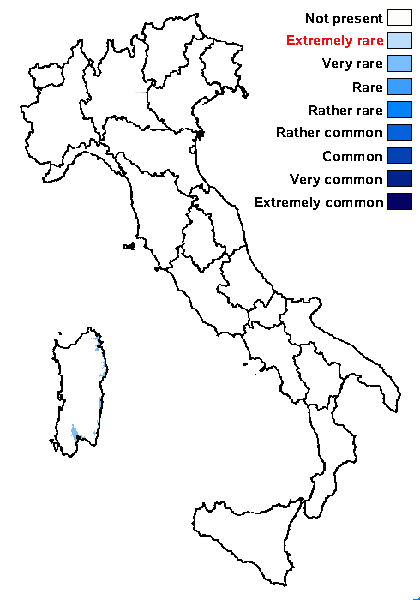Pyrenopsis micrococca (Bornet & Nyl.) Forssell
N. Acta Reg. Soc. Sci. Upsal., ser. 3, 13: 45, 1885. Basionym: Synalissa micrococca Bornet & Nyl. - Mém. Soc. Sc. Nat. Cherbourg, 4: 231, 1856.
Synonyms:
Distribution: C - Sar.
Description: Thallus crustose, episubstratic, slightly gelatinous when wet, black when dry, dark red when wet, entirely granulose, the granules 0.1-0.2(-0.3) mm wide, usually more or less dispersed and not aggregated into areoles. Thallus anatomy homoiomerous and paraplectenchymatous throughout, with a network of hyphae enclosing the photobiont cells, Apothecia pycnoascocarps, immersed, 0.2-0.45 µm across, perithecioid, with a pore-like disc, and a thin, granulose thalline margin. Epithecium orange-brown; hymenium colourless, K/I+ blue; paraphyses simple or sparingly branched and anastomosing in upper part, more or less constricted at septa; subhymenium colourless. Asci 8-spored, subcylindrical, functionally unitunicate, the wall I+ blue. Ascospores 1-celled, hyaline, ellipsoid, 11-16 x 6-8 µm. Pycnidia immersed, pyriform. Conidia ellipsoid, very small. Photobiont cyanobacterial, chroococcoid, the cells single or clustered, surrounded by a reddish-violet gelatinous sheath. Spot tests: all negative. Chemistry: without lichen substances. Note: a very poorly known and rarely collected species, found on basic siliceous rocks, in sun-exposed seepage tracks, mostly in the Mediterranean belt, near the coast.
Growth form: Crustose
Substrata: rocks
Photobiont: cyanobacteria, coccaceous (e.g. Gloeocapsa)
Reproductive strategy: mainly sexual
On otherwise dry surfaces with short periods of water seepage after rain
Taxon bound to maritime-coastal situations
Commonnes-rarity: (info)
Alpine belt: absent
Subalpine belt: absent
Oromediterranean belt: absent
Montane belt: absent
Submediterranean belt: absent
Padanian area: absent
Humid submediterranean belt: absent
Humid mediterranean belt: absent
Dry mediterranean belt: very rare

Predictive model
Growth form: Crustose
Substrata: rocks
Photobiont: cyanobacteria, coccaceous (e.g. Gloeocapsa)
Reproductive strategy: mainly sexual
On otherwise dry surfaces with short periods of water seepage after rain
Taxon bound to maritime-coastal situations
Commonnes-rarity: (info)
Alpine belt: absent
Subalpine belt: absent
Oromediterranean belt: absent
Montane belt: absent
Submediterranean belt: absent
Padanian area: absent
Humid submediterranean belt: absent
Humid mediterranean belt: absent
Dry mediterranean belt: very rare

Predictive model
 Index Fungorum
Index Fungorum
 GBIF
GBIF

